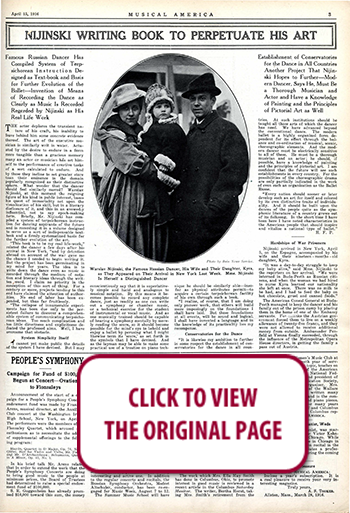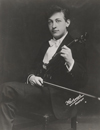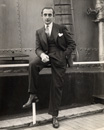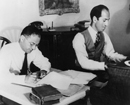 100 YEARS AGO IN MUSICAL AMERICA (139)
100 YEARS AGO IN MUSICAL AMERICA (139)
April 15, 1916
Page 3
NIJINSKI WRITING BOOK TO PERPETUATE HIS ART
Famous Russian Dancer Has Compiled System of Terpsichorean Instruction Designed as Text-book and Basis for Further Evolution of the Ballet—Invention of Means of Recording the Dance as Clearly as Music Is Recorded Regarded by Nijinski as His Real Life Work—Establishment of Conservatories for the Dance in All Countries Another Project That Nijinski Hopes to Further—Modern Dancer, Says He, Must Be a Thorough Musician and Actor and Have a Knowledge of Painting and the Principles of Pictorial Art as Well
THE actor deplores the transient nature of his craft, his inability to leave behind him some concrete evidence thereof. The art of the executive musician is similarly writ in water. Actuated by the desire to endure in a form more tangible than a gracious memory many an actor or musician has set himself to the performance of creative tasks of a sort calculated to endure. And by these they incline to set greater store than their eminence in the domain popularly recognized as their distinctive sphere. What wonder that the dancer should feel similarly moved? Warslav Nijinski at this moment the reigning figure of his kind in public interest, bases his quest of immortality not upon the visualization of his skill, but in a literary disclosure of it, and this in an avowedly influential, not to say epoch-making form. Briefly, Mr. Nijinski has compiled a system of terpsichorean instruction for dancing aspirants of the future and is recording it in a volume designed to serve as a sort of indispensable textbook and a firmly systematized basis for the further evolution of the art.
“This book is to be my real life-work,” related the dancer a few days after his arrival in New York, “and by detention abroad on account of the war gave me the chance I needed to begin writing it. But the project has been germinating in my mind for years. The idea is to write down the dance even as music is recorded through the medium of notation and literary ideas through the written word. I claim no priority in the conception of this sort of thing. For a century or more, projects tending to this end have claimed the attention of authorities. No end of labor has been expended, but thus far fruitlessly.
“The collapse of innumerable experiments has been due only to the persistent failure to discover a comprehensible system of communicating terpsichorean ideas. Too much complication and too little directness and explicitness defeated the professed aims. Well, I have overcome that obstacle.
System Simplicity Itself
I cannot yet make public the details of the system I have devised. But I may conscientiously say that it is superlatively simple and lucid and analogous to musical notation. By this means it becomes possible to record any complete dance, just as readily as one can write out a symphony or chamber music, or a technical exercise for the student of instrumental or vocal music. And as one musically trained should be capable of hearing a symphony mentally by merely reading the score, so it should become possible for the mind’s eye to behold and enjoy a ballet by perusing what I might likewise term its ‘score,’ as set forth in the symbols that I have devised. And as the layman may be able to make some practical use of a treatise on piano technique he should be similarly able—insofar as physical attributes permit—to acquire a certain terpsichorean facility of his own through such a book.
“I realize, of course, that I am doing only pioneer work, that others will build more imposingly on the foundations I shall have laid. But these foundations at all events, will be sound and logical. I shall have invented a language and in the knowledge of its practicality lies my recompense.
Conservatories for the Dance
“It is likewise my ambition to further in some respect the establishment of conservatories for the dance in all countries. At such institutions should be taught all those arts of which the dancer has need. We have advanced beyond the conventional dance. The modern ballet is a highly organized form dependent for its effect through the balance and co-ordination of musical, scenic, choreographic elements. And the modern dancer must be electrically sensitive to all of these. He must be a thorough musician and an actor; he should, if possible, have a knowledge of painting and the principles of pictorial art. I am confident that the future will see such establishments in every country. For the possibilities of the choreographic drama are only partially indicated in the work of even such an organization as the Ballet Russe.
“Every nation should sooner or later develop such an art for itself and colored by its own distinctive traits of individuality. And it should be built upon the dances of the people quite as the symphonic literature of a country grows out of its folksong. In the short time I have been here I have noted characteristics in the American people that should inspire and vitalize a national type of ballet.” —H. F. P.
Hardships of War Prisoners
Nijinski arrived in New York, April 5, on the Espagne, accompanied by his wife and their nineteen-months-old daughter, Kyra.
“It was a day-to-day struggle to keep my baby alive,” said Mme. Nijinski to the reporters on her arrival. “We were interned in Buda-Pesth as Russian citizens, and when the woman we had hired to nurse Kyra learned our nationality she left at once. There was no milk to be had, and I had to feed the baby on hot chocolate, gruel and canned foods.”
The American Consul General at Buda-Pesth managed to keep the dancer and his family out of the prison camp by placing them in the home of one of the Embassy servants. For months the Austrian government forced them to live on a weekly allowance of twenty-five francs, and they were not allowed to receive additional money from outside. Ambassador Penfield at Vienna finally succeeded, through the influence of the Metropolitan Opera House directors, in getting the family a pass out of Austria.




 RENT A PHOTO
RENT A PHOTO





